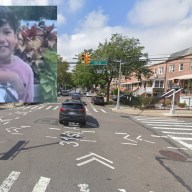“They don’t have enough money for…
By Tien-Shun Lee
Elena Turull, a food distributor at the food pantry operated by St. Nicholas of Tolentine church in Jamaica, says she hears the same thing over and over again: People have lost their jobs and they can’t make ends meet.
“They don’t have enough money for food,” Turull said. “We’re like a stop-over until hopefully they can find something else permanently. They come back, sometimes for over a year or more, the same people.”
According to a recent study conducted by the Hunger Action Network of New York State, a public policy and community outreach organization which aims to reduce hunger and poverty, 92 percent of emergency food programs in Queens reported that the number of users citing recent job loss as a reason has increased in the last year.
“Typically they’re people who have recently lost their jobs or who have experienced a reduction in the number of hours or days that they work, and there’s certainly been an increase in the number of working poor people using food programs,” said Susannah Pasquantonio of the Hunger Action Network.
Although the current 6.7 percent unemployment rate in Queens lags behind the 8 percent jobless rate for the city as a whole, the borough is feeling the pinch in terms of hunger.
Many factors, including the ripple effects from the World Trade Center attacks, the large city budget deficit, the current recession and a continued low minimum wage have resulted in an increase in the number of people seeking help from emergency food programs.
“The bottom line is there’s an unemployment crisis and a low-wage crisis in New York,” said Jonathan Rosen, director of the New York Unemployment Project in Manhattan. “If you work for minimum wage, it’s impossible to feed your family, and the number of people suffering from long-term unemployment is the highest it’s been in 10 years.”
According to the Hunger Action Network, when data from September 2002 was compared with data from September 2001, there was a 25 percent increase in demand for emergency food in Queens. Citywide, 92 percent of emergency food programs said they had experienced an increase in demand for food, when comparing data from those two months.
Esther Schenker, director of the food pantry at the Jewish Services Coalition in Far Rockaway, said more than 500 new clients had showed up to collect food at her center within the last year.
“The situation is very bad,” Schenker said. “It’s not just the marginally poor who are now poor. It’s people who were doing really well, then they lost their job. It’s a new thing for them. They don’t know the system, and they don’t want to come for food packages.”
Many people who were laid off after Sept. 11 are just coming forward now for assistance, Pasquantonio said.
“There are many hardworking people who never had to rely on government assistance or charities, and now their unemployment has run out, so they’re just now coming forward for assistance,” she said.
Pasquantonio said that fewer than 20 percent of people who use emergency food programs are homeless. Depending on the program, 30 percent to 70 percent of users have jobs, she said.
According to Robyn Stein, a spokeswoman for City Harvest, an organization that collects food donations and leftover food from restaurants and then delivers it to emergency food programs, one out of every five New York City residents goes to an emergency food program for food.
“It’s very invisible. It could be you or me,” Stein said. “When doing the budget, you have set costs — rent, electricity, phone — so what gets cut? The food budget.”
Carl Strong, a spokesman for the city’s Human Resources Administration, said the number of people in the city who use food stamps increased by more than 35,000 from January to December last year. Significantly, the number of people using food stamps who are not on welfare increased by 24 percent.
Even with the increase, the food stamp program is still highly underused. In Queens, 343,132 residents are eligible to receive food stamps, but only 125,461 residents, or about 37 percent, take advantage of the assistance, according to a report by the Community Food Resource Center, a non-profit advocacy organization.
The report cites language barriers, poor attitudes and red tape as reasons for the borough’s low participation in the food stamp program, which gives people plastic cards that function like a credit card for food.
Avila Miriam, an immigrant from Ecuador who lives in Corona with her 8-year-old daughter and 19-year-old son, said she had no choice but to turn to emergency food assistance after she lost her job at Kennedy Airport cleaning airplanes in 2001.
“It’s so difficult to find work,” she said. “I have my applications out all over the place, but nobody’s called me.”
Reach reporter Tien-Shun Lee by e-mail at Timesledger@aol.com, or call 229-0300, ext. 155.

































